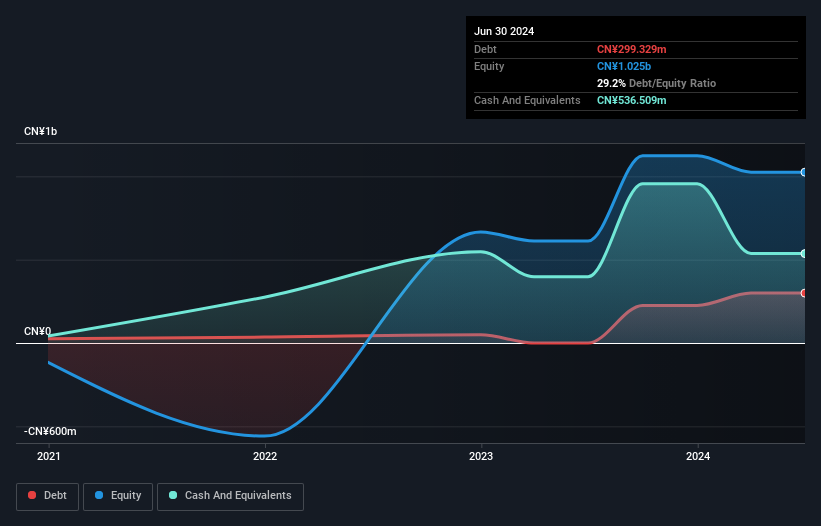The external fund manager backed by Berkshire Hathaway’s Charlie Munger, Li Lu, makes no bones about it when he says ‘The biggest investment risk is not the volatility of prices, but whether you will suffer a permanent loss of capital.’ When we think about how risky a company is, we always like to look at its use of debt, since debt overload can lead to ruin. As with many other companies iMotion Automotive Technology (Suzhou) Co., Ltd. (HKG:1274) makes use of debt. But should shareholders be worried about its use of debt?
Why Does Debt Bring Risk?
Debt assists a business until the business has trouble paying it off, either with new capital or with free cash flow. Ultimately, if the company can’t fulfill its legal obligations to repay debt, shareholders could walk away with nothing. While that is not too common, we often do see indebted companies permanently diluting shareholders because lenders force them to raise capital at a distressed price. Having said that, the most common situation is where a company manages its debt reasonably well – and to its own advantage. When we examine debt levels, we first consider both cash and debt levels, together.
See our latest analysis for iMotion Automotive Technology (Suzhou)
What Is iMotion Automotive Technology (Suzhou)’s Net Debt?
As you can see below, at the end of June 2024, iMotion Automotive Technology (Suzhou) had CN¥299.3m of debt, up from none a year ago. Click the image for more detail. However, it does have CN¥536.5m in cash offsetting this, leading to net cash of CN¥237.2m.

A Look At iMotion Automotive Technology (Suzhou)’s Liabilities
The latest balance sheet data shows that iMotion Automotive Technology (Suzhou) had liabilities of CN¥495.5m due within a year, and liabilities of CN¥78.6m falling due after that. Offsetting this, it had CN¥536.5m in cash and CN¥381.2m in receivables that were due within 12 months. So it actually has CN¥343.6m more liquid assets than total liabilities.
This short term liquidity is a sign that iMotion Automotive Technology (Suzhou) could probably pay off its debt with ease, as its balance sheet is far from stretched. Simply put, the fact that iMotion Automotive Technology (Suzhou) has more cash than debt is arguably a good indication that it can manage its debt safely. When analysing debt levels, the balance sheet is the obvious place to start. But it is future earnings, more than anything, that will determine iMotion Automotive Technology (Suzhou)’s ability to maintain a healthy balance sheet going forward. So if you’re focused on the future you can check out this free report showing analyst profit forecasts.
Over 12 months, iMotion Automotive Technology (Suzhou) made a loss at the EBIT level, and saw its revenue drop to CN¥1.3b, which is a fall of 13%. That’s not what we would hope to see.
So How Risky Is iMotion Automotive Technology (Suzhou)?
Statistically speaking companies that lose money are riskier than those that make money. And the fact is that over the last twelve months iMotion Automotive Technology (Suzhou) lost money at the earnings before interest and tax (EBIT) line. And over the same period it saw negative free cash outflow of CN¥738m and booked a CN¥194m accounting loss. With only CN¥237.2m on the balance sheet, it would appear that its going to need to raise capital again soon. Overall, its balance sheet doesn’t seem overly risky, at the moment, but we’re always cautious until we see the positive free cash flow. When analysing debt levels, the balance sheet is the obvious place to start. But ultimately, every company can contain risks that exist outside of the balance sheet. Case in point: We’ve spotted 3 warning signs for iMotion Automotive Technology (Suzhou) you should be aware of, and 2 of them are a bit unpleasant.
When all is said and done, sometimes its easier to focus on companies that don’t even need debt. Readers can access a list of growth stocks with zero net debt 100% free, right now.
Valuation is complex, but we’re here to simplify it.
Discover if iMotion Automotive Technology (Suzhou) might be undervalued or overvalued with our detailed analysis, featuring fair value estimates, potential risks, dividends, insider trades, and its financial condition.
Access Free Analysis
Have feedback on this article? Concerned about the content? Get in touch with us directly. Alternatively, email editorial-team (at) simplywallst.com.
This article by Simply Wall St is general in nature. We provide commentary based on historical data and analyst forecasts only using an unbiased methodology and our articles are not intended to be financial advice. It does not constitute a recommendation to buy or sell any stock, and does not take account of your objectives, or your financial situation. We aim to bring you long-term focused analysis driven by fundamental data. Note that our analysis may not factor in the latest price-sensitive company announcements or qualitative material. Simply Wall St has no position in any stocks mentioned.
